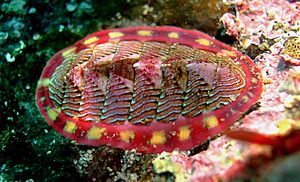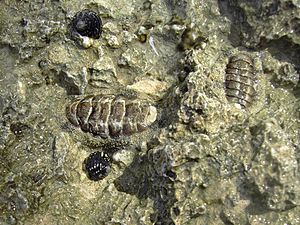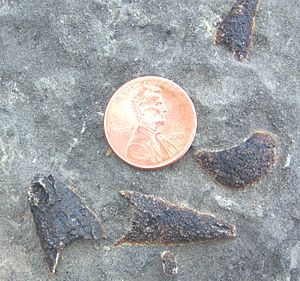Chiton facts for kids
Quick facts for kids Chiton |
|
|---|---|
 |
|
| Lined chiton, Tonicella lineata. The eight plates on this chiton's shell are easy to see. | |
| Scientific classification | |
| Kingdom: | |
| Subkingdom: | |
| Phylum: | |
| Class: |
Polyplacophora
Blainville, 1816
|
| Subclass: |
†Multiplacophora,
†Paeleoplacophora, Neoloricata |
Chitons are amazing sea creatures that belong to a group called molluscs. They live in the ocean and are part of the class Polyplacophora. People sometimes call them sea cradles or coat-of-mail shells because of their unique look. There are about 900 to 1,000 different kinds, or species, of chitons alive today. Most of them are quite small, usually between 0.5 and 30 centimeters long.
Chitons have a special shell that helps them stick to rocks, much like a limpet. This shell is made of eight hard plates that fit together tightly, overlapping each other. A soft, fleshy ring called a 'girdle' surrounds these shell plates.
Contents
What is a Chiton?
The name Polyplacophora means "many plates." This refers to the chiton's shell, which is made of a strong mineral called calcium carbonate. This shell is quite flexible, allowing the chiton to even roll into a ball for protection!
Underneath the eight shell plates, a chiton has a strong muscular foot. This foot helps the chiton move slowly over rocks and other surfaces, whether it's in or out of the water. Chitons also have a special tongue-shaped part called a radula. It has many rows of 17 tiny teeth.
What do Chitons Eat?
Some chitons use their radula to scrape algae off rocks. Others are meat-eaters, catching tiny zooplankton and other small animals that live in shallow water.
Chiton Appearance
Chitons can be less than an inch long or grow up to a foot! They come in many different colors, like black, red, pink, and even blue. Their shells can be shiny or dull, and they might feel smooth, hairy, scaly, or spiny, depending on the species.
Chiton Body Parts
If you were to carefully pick up a chiton and turn it over, you wouldn't see any eyes, legs, or arms. Instead, you would see its wide foot in the center. The radula, which it uses for scraping food, is also visible.
Right under the shell is the chiton's mantle. The lowest part of the mantle extends out from under the shell's edge. This part, called the girdle, helps the foot grip surfaces. In some chitons, the girdle can even cover the bottom half of the shell.
Chiton Habits

Most chitons are nocturnal, meaning they feed at night. During the day, they often hide under rocks. Their main home is the intertidal zone, which is the area along the coast that is covered by water at high tide and exposed to air at low tide.
They live on hard surfaces like rocks, or in cracks within rocks. Some species live high up in the intertidal zone, where they are exposed to the air and sunlight for long periods. Other chitons live deeper in the water, and a few species can even be found in very deep water, up to 6,000 meters (about 20,000 feet) down!
Ancient Chitons
Chitons have a long and interesting history! We have found many chiton fossils, showing that they have been around for at least 400 million years, since the Devonian period. Some very old organisms from the Cambrian period, like Matthevia, might even be early relatives of chitons.

Scientists think that chitons might have developed from an earlier type of mollusc that had a single shell. Over time, this single shell might have evolved into the multiple, overlapping plates we see on modern chitons, giving them better protection.
Images for kids
-
Loose valves or plates of Chiton tuberculatus from the beachdrift on Nevis, West Indies. You can see the head plates at the top and tail plates at the bottom.
-
The different stages of chiton development: The first image shows a trochophore larva, the second is during metamorphosis, and the third is an immature adult chiton.
See also
 In Spanish: Quitones para niños
In Spanish: Quitones para niños





